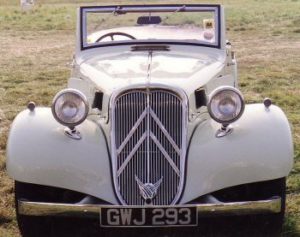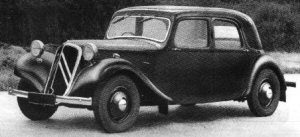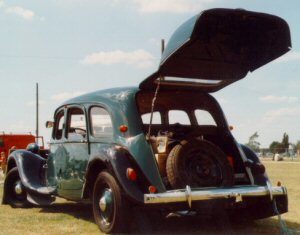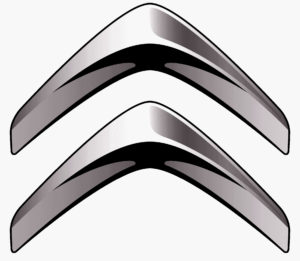The Horse before the Cart – 1934 to 1955
In 1934, Citroën shook the world with the first mass-produced front wheel drive car – the famous Traction Avant.
It was low, smooth, streamlined; allowed very positive handling, and a safe comfortable ride – It took the world by storm! The vast majority of today’s cars all owe Citroën an immense debt, through the pioneering of FWD. The Traction proved to be a fitting memorial to André Citroën, who tragically died shortly before the car became available, burdened by the development costs of this great gamble. The Traction went on to become one of the great success stories of this era, becoming synonymous with the Resistance in WW2, as well as pre- and post-war Parisian streets.
It is largely thanks to the Traction Avant – fondly referred to as The Maigret Car – that Citroën earned its reputation for advanced technology and innovative engineering. Those cars built before 1934 wearing the now famous Double Chevron emblem arguably might be considered as being somewhat conventional, but it is the Traction Avant which was responsible for changing Citroën’s fortunes and reshaping automobile history.
When André Citroën embarked on developing the Traction Avant he took a huge risk, a risk which ultimately cost him his company. Traction Avant, which translates as front drive, was by no means a new idea. What was novel was that fact that it was untried in relation to mass production techniques.

The basis of Citroën’s affair with the Traction Avant stems from his desire to produce a car that was technologically ahead of those of his rivals, namely Renault and Peugeot. Such an opportunity arose when he visited the Budd Corporation in America in the early 1930s: having been shown a proposal for a vehicle incorporating chassis and body as a single unit, ie chassis-less or monocoque construction, he instinctively knew this to be the design to put him years ahead of the opposition. The prototype also displayed a low centre of gravity, made possible by placing the gearbox ahead of the engine to drive the front wheels, and styling which was rakish compared to most other cars, which were upright in stance.
André Citroën drew up his team to develop the new car. The Italian Flaminio Bertoni was put in charge of styling while André Lefebvre headed a dedicated engineering team. Though a young man, Lefebvre was highly experienced having previously worked for Gabriel Voisin, the aeroplane and motorcar constructor. Citroën gave his design team a virtually impossible task: the car had to be ready for introduction in May 1934.

The Traction Avant bristled with technology. In addition to front-wheel drive and monocoque bodyshell, specification included hydraulic braking, all-round independent torsion bar suspension to afford the best possible ride quality, and a wet-liner four-cylinder overhead valve engine. Initial proposals had called for automatic transmission, until this proved too time consuming to perfect within the stringent timescale.
Despite Lefebvre’s petitions to delay introduction of the car until it could be fully perfected, Citroën insisted otherwise. The reason for his persistence was that spiralling development costs had put such a huge strain on the firm’s resources he was unable to stave off his creditors beyond the car’s planned debut. When unveiled, the Traction Avant was far from being ready. Problems existed with the transmission arrangement, the design of drive shaft having proved unreliable. There were also difficulties in perfecting the bodyshells, but none of the problems were insurmountable given sufficient development time. The outcome was that the car went into production before it was ready, and many complaints were received from dissatisfied customers. The firm’s creditors were also anxious to be repaid and ultimately Citroën went into receivership, Michelin finally taking control of the company.
With Michelin’s investment André Lefebvre was allowed to perfect the car and within months all the problems were resolved. Here was a car that was reliable with outstanding performance. With front-wheel drive, the car’s handling characteristics were phenomenal and won praise from every quarter, to include even W.O. Bentley whose sports cars were without equal and who owned an example for many years. The Traction Avant’s 1300cc engine was underpowered and within a short time two new engines were introduced. One was a1600cc unit but it was the 1911cc engine that was really popular and which afforded sparkling performance. In this form the 2-litre engine remained the principal four-cylinder power source for the remaining duration of production.

Few specification changes were applied to the car during its production period which ended in 1957. Rack and pinion steering was introduced in 1936 along with minor restyling to allow for an externally accessible boot. In early post-war years bonnets were redesigned to afford improved ventilation and from 1952 the boot was enlarged and the spare wheel carried within rather than externally.
Early production centred around the Legere or ‘Light’ model; later came a larger derivative known as the Normale with wider track and longer wheelbase. Other variants include a Limousine, a seven-seater Familiale and a Commerciale with a tailgate, the precursor to the modern hatchback. Additional to the model range were a Coupé and Cabriolet, neither of which were included in the post-war catalogue.
At the Traction’s launch in 1934 it had been proposed to offer a V8 derivative with even more streamlined styling. This was to be a car in the league of the grande routiers , but development was complex and too costly. Though a number of prototypes were built the car never went into production. By the end of the 1930s Citroën was ready to unveil a luxury model with a 2866cc six-cylinder engine. This provided the Traction’s ultimate performance and remained in the catalogue until the end of production.
For 1954 Citroën introduced the 6H, a six-cylinder model having hydropneumatic self-levelling rear suspension. A year ahead of the launch of the amazing DS, Citroën gave a preview of what was to come.
The Traction Avant was also built in Britain at Citroën’s Slough factory. The cars built in England were nearly identical to their Paris-built siblings but incorporated a large percentage of UK-sourced components, such as electrics (12-volts rather than 6-volts), radiators, bumpers, wheels, lighting systems, instrumentation and seats. Slough cars have interiors intended to appeal to British motorists and featured hide upholstery and wooden dashboards, all of which gives them a certain appeal which is appreciated by Traction connoisseurs. Production of the Traction Avant continued until the DS was announced in 1955, after which the factory was re-tooled for assembly of the new model.
The Slough equivalent of the Legere is the Super Modern Twelve and Light Fifteen, the latter having the four-cylinder 1911cc engine. Normales were known as Big Fifteens and the six-cylinder model as the Six and Six-H.
The Traction Avant is a car that is highly sought by motoring enthusiasts seeking a classic car that is affordable and eminently usable. At an event held in Dunkirk to celebrate the Traction’s 70th anniversary, nearly 1000 examples collected to pay homage to a design that at the end of its production span was more advanced than many new 1957 models.


